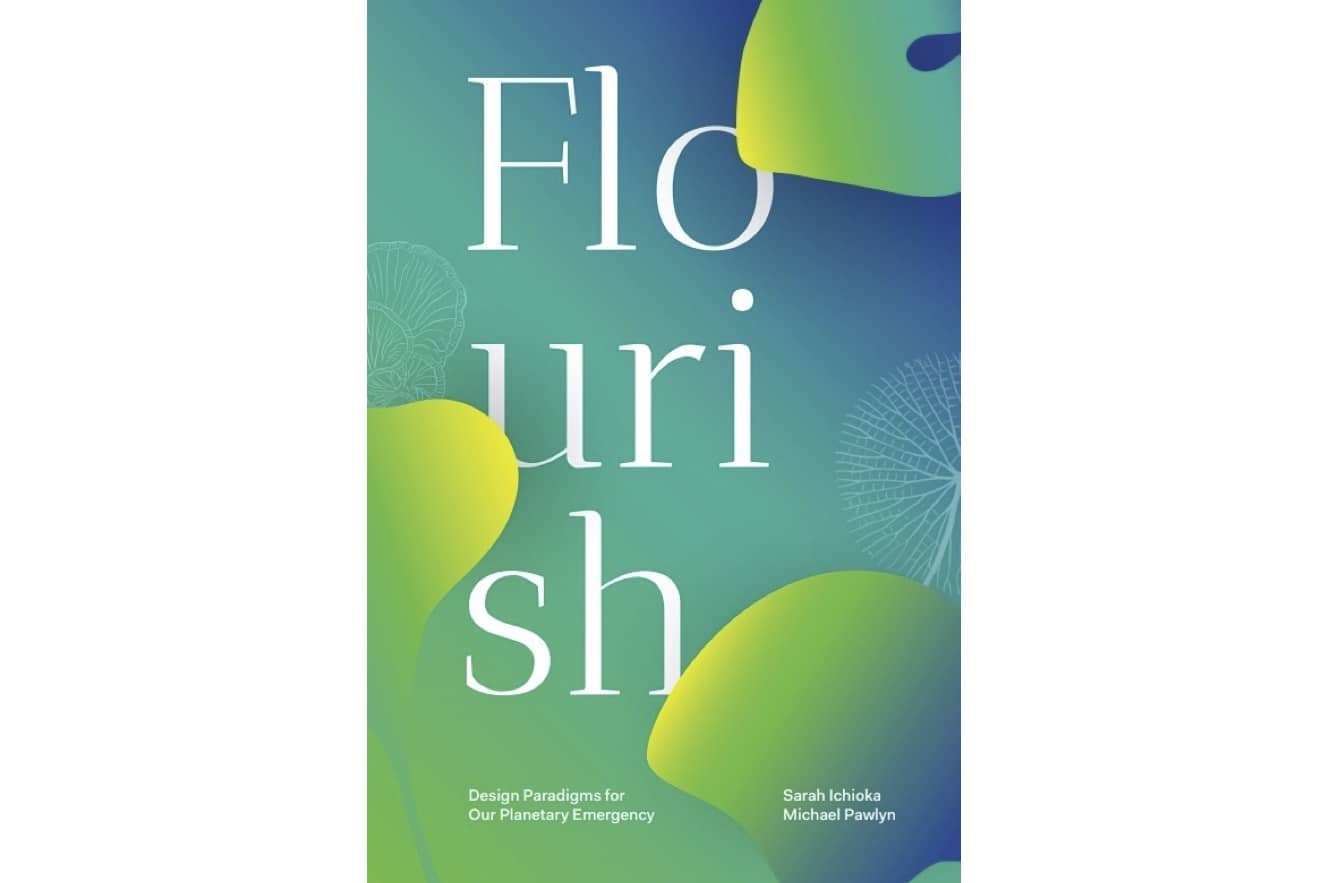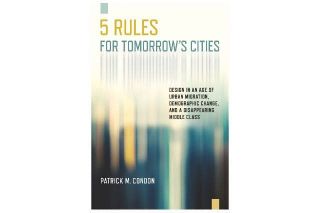
www.buildingsandcities.org/insights/reviews/flourish-design-paradigms.html
Flourish: Design Paradigms for Our Planetary Emergency

By Sarah Ichioka and Michael Pawlyn. Triarchy Press, 2021, ISBN: 9781913743260
Raymond J. Cole reviews this book, which stimulates urgent debate about systems level change for the built environment: embracing regenerative design and development. Design professionals can (and must) do better: they have the agency to create the transformative changes needed to address ecological and climatic crises.
We have had numerous past warnings of the environmental consequences of endless economic growth, the inherent exploitative nature of capitalism, and an almost complete reliance on the burning of fossil fuels. Unfolding dramatic changes in the global climate is but one manifestation that something is seriously wrong in the way we currently inhabit this planet and hopefully sufficient to prompt us to seriously rethink what we value and our relationship with living systems. The day-to-day decisions and choices made by design professionals engaged in the production of the built environment will be particularly critical in charting a path towards a qualitatively different future - one where natural systems are not on the verge of collapse as a result of human activity but are thriving. In Flourish: Design Paradigms for Our Planetary Emergency, rather than considering this transformation an insurmountable challenge, Sara Ichioka and Michael Pawlyn are persuaded that:
"[n]ow is exactly the right moment to be maximizing our agency in bringing about positive, systems level change." (p.19)
Drawing from Donella Meadows' (1999) leverage points, they focus on cultivating new paradigms as key to such a transformation and they position regenerative approaches as a necessary guide for future development and design. Ichioka and Pawlyn reference conversations with other design professions who expressed that they feel they little agency to effect change and, importantly, one of the ambitions they set for the book is to remind them that they do.
The key concepts, principles and ideas related to regenerative development and design discussed in Flourish are not new. The Regenesis Group, for example, have been exploring them since 1995, Janis Birkeland's work from 2002 onwards emphasized how the built environment can build rather than diminish natural capital, and Dominique Hes and Chrisna du Plessis' 2014 book - Designing for Hope: Pathways to Regenerative Sustainability - examined ways of finding visible pathways that would lead us into a thriving future in a regenerative world. Importantly, the Regenesis Group (n.d.) emphasize that:
"regenerative development is based on the premise that we cannot make the outer transformations that are needed in our communities without first making inner transformations, both individually and collectively, in how we think, how we work, and, ultimately, who we are as people."
While the issues that Ichioka and Pawlyn raise and discuss in Flourish will likely be of interest to a broad readership, their stated intention is to change the mindsets of design professionals and to equip them with arguments to convince their colleagues and clients to shed outmoded practices.
Ichioka and Pawlyn are both accomplished professionals in their respective fields - urbanism and architecture - and their previous work includes eco-villages and biomimetic design respectively. The genesis of Flourish was their acceptance in late-2018 that building environmental practices were woefully insufficient to address the mounting environmental threats and that regenerative approaches offered a far more potent path forward. Both authors share a commitment that design professionals can do better and position the value they offer through the book as "interpreters and intermediaries, bringing the ideas of transformative thinkers from other disciplines and communities" (p.19) who had inspired their own work to a wider audience. In this sense the book does not claim to be a comprehensive coverage of regenerative development and design, nor does it provide an even reporting of their core concepts and principles. It can be seen as capturing those that they personally found compelling and valuable and to make them accessible to others in a readable form.
One of the most valuable aspects of the book is the questions it poses to capture the possible doubts that design professionals and their clients may have regarding the ability to make significant but necessary changes in their practices and expectations. This provided the authors with the opportunity to present arguments to counter these reservations and help hold the reader's attention as they navigate through the stream of ideas covered in the book. Among the many responses they offer, "showing leadership in their respective roles" and choosing the opportune moment for designers to "to ask constructively provocative questions" (p. 83) to inspire their clients are particularly powerful. Ichioka and Pawlyn suggest that a "regenerative design culture" will require built environment professionals to reposition their role from lone "Critic-Consumer" to a "Conductor-Designer" who both nurtures collaboration and cooperation among participants and provides a unifying role to bring the best out of individual abilities (p. 107).
The book's overall ambition is immensely important - one that most readers will find both engaging and inspiring. While there are many ways to structure ideas and arguments in a book, Flourish obviously represents the outcome of the authors' personal journey to both understand regenerative development and design and find the best ways to tell their story to others. Indeed, readers will appreciate Ichioka and Pawlyn's fresh voyage through the large amount of information and publications they had engaged to shape their arguments. The ideas in Flourish are structured and unpacked in what they consider as five key necessary "paradigm shifts" - Positivism, Co-evolution as Nature, A Longer Now, Symbiogenesis, and Planetary Health. Much of the material covered in these will be useful for those not familiar with earlier regenerative development and design literature, as will summary Table 4 (p. 143) that captures the necessary shifts in concepts currently held toward those advocated in Flourish and that had been discussed in the earlier chapters. By Ichioka and Pawlyn's own admission, this table is a daunting list for design professionals. Moreover, if inspired and receptive, design professionals are faced with the challenge of translating these into their own decision-making and practice. Making the fundamental transformations advocated in the book will take time, thereby raising issues of timeframes and rate of change, and the forces that accelerate or slow them. How quickly both design professionals and the institutions that control practice can change and, even more significant, make these evident in the built environment become important questions. Hopefully, the physical transformation of the built environment can be made within the shrinking time available before environmental tipping points are passed.
In the book's introduction, the authors take issue with Bloomberg LP's recent European headquarters building in London that, although having exemplary environmental performance evaluated through the Building Research Establishment's Environmental Assessment Method (BREEAM), still fell short of what they considered necessary to meet the severity of the global environmental crisis. In doing so, they thereby raise the expectation for the reader that later chapters would offer a clearer understanding of what new developments would be like if guided by the new mindset and regenerative principles and by projects presented in the book. Indeed, this is likely one of the litmus tests of the book's value for design professionals. A broader audience would likely be interested in how regenerative approaches would enhance the buildings they inhabit and the neighbourhoods where they live, both now and in the future.
Although the majority of the book focusses on necessary paradigm shifts, being design professionals themselves, it is somewhat surprising that Ichioka and Pawlyn provide so little coverage of the projects accompanying the various ideas and concepts that relate more directly to the built environment. Given that their aim is to shift design professionals' mindsets as a precursor to action, it is reasonable to argue that case-studies that embody new ways of thinking are perhaps as valuable in convincing designers and clients as the literature they have cited. The authors correctly acknowledge that few built "comprehensive" regenerative projects currently exist and therefore have presented a number of examples which "show important aspects" of regenerative approaches - "green shoots" as they call them. Those more directly related to the built environment are drawn from a wide range of geographical and cultural contexts, some emerged from powerful top-down intervention, and some are bottom-up community initiatives. One would have perhaps expected that these would be viewed and critiqued more explicitly through the lens of the transformations contained in Table 4.
Regenerative practitioners, like the Regenesis Group, prioritize the understanding and engagement of the unique qualities and potential of both places and the people who live in them, and this helps them to tie many ideas and strategies together. Although Ichioka and Pawlyn acknowledge "place", it is not emphasized or illustrated strongly in the book. For example, the image of the Biomimetic Office building (p. 83) is shown without any context or information on the connection to, or influence by or on, its surroundings, and the Gibbon's Rent community garden (p. 89) is similarly presented very much as a world unto itself and, with what appears to be anti-climb spikes on enclosing walls, an impenetrable enclosing boundary. Perhaps most important, regenerative approaches seem equally, if not more, about processes and discussions that shape projects rather than the final outcome. Here, it would have been useful to have been provided with more insights into how the projects emerged and, importantly, which and how various stakeholders were involved in the development and design process. These can of course be addressed in future editions of the book and other formats as regenerative practices mature and become more widespread, and discussions shift from 'why to' to 'how to'. Moreover, Flourish, having now provided readers with access to the necessary change in mindset they themselves had made, Ichioka and Pawlyn would also be able to report on how regenerative concepts had shaped their own work.
Flourish is a welcome addition to a mounting body of literature promoting regenerative approaches that both frame and guide how we engage in the design of the built environment. One hopes that it is widely read and impactful so as to further Ishioka and Pawlyn's primary ambition to "stimulate urgent debate about regenerative design and development" (p. 142). The greater influence of Flourish therefore perhaps resides in the various activities that the Royal Society of the Arts (RSA 2022) are organising around the topic. These, now linked to Ishioka and Pawlyn's timely contribution, have the potential to reach a broader audience, foster discussions and help to propagate regenerative ideas and practices further and faster.
References
Birkeland, J. (2002). Design for Sustainability: A Sourcebook for Eco-Logicial Solutions. London: Earthscan.
Hes, D. and du Plessis, C. (2015). Designing for Hope, Pathways to Regenerative Sustainability. Abingdon: Routledge.
Mang, P. and Haggard, B. (2016). Regenerative Development and Design: A Framework for Evolving Sustainability. Hoboken, NJ: John Wiley & Sons.
Meadows, D.H. (1999). Leverage Points: Places to Intervene in a System. Hartland, VT: The Sustainability Institute. https://donellameadows.org/archives/leverage-points-places-to-intervene-in-a-system/
Regenesis Group. (n.d.). The regenerative practitioner series. https://regenesisgroup.com/the-regenerative-practitioner-working-program-overview/
RSA. (2022). Design paradigms for a regenerative future. (event) https://www.thersa.org/events/2022/01/design-paradigms-for-a-regenerative-future
Latest Peer-Reviewed Journal Content
Designing for pro-environmental behaviour change: the aspiration–reality gap
J Simpson & J Uttley
Lifetimes of demolished buildings in US and European cities
J Berglund-Brown, I Dobie, J Hewitt, C De Wolf & J Ochsendorf
Expanding the framework of urban living labs using grassroots methods
T Ahmed, I Delsante & L Migliavacca
Youth engagement in urban living labs: tools, methods and pedagogies
N Charalambous, C Panayi, C Mady, T Augustinčić & D Berc
Co-creating urban transformation: a stakeholder analysis for Germany’s heat transition
P Heger, C Bieber, M Hendawy & A Shooshtari
Placemaking living lab: creating resilient social and spatial infrastructures
M Dodd, N Madabhushi & R Lees
Church pipe organs: historical tuning records as indoor environmental evidence
B Bingley, A Knight & Y Xing
A framework for 1.5°C-aligned GHG budgets in architecture
G Betti, I Spaar, D Bachmann, A Jerosch-Herold, E Kühner, R Yang, K Avhad & S Sinning
Net zero retrofit of the building stock [editorial]
D Godoy-Shimizu & P Steadman
Co-learning in living labs: nurturing civic agency and resilience
A Belfield
The importance of multi-roles and code-switching in living labs
H Noller & A Tarik
Researchers’ shifting roles in living labs for knowledge co-production
C-C Dobre & G Faldi
Increasing civic resilience in urban living labs: city authorities’ roles
E Alatalo, M Laine & M Kyrönviita
Co-curation as civic practice in community engagement
Z Li, M Sunikka-Blank, R Purohit & F Samuel
Preserving buildings: emission reductions from circular economy strategies in Austria
N Alaux, V Kulmer, J Vogel & A Passer
Urban living labs: relationality between institutions and local circularity
P Palo, M Adelfio, J Lundin & E Brandão
Living labs: epistemic modelling, temporariness and land value
J Clossick, T Khonsari & U Steven
Co-creating interventions to prevent mosquito-borne disease transmission in hospitals
O Sloan Wood, E Lupenza, D M Agnello, J B Knudsen, M Msellem, K L Schiøler & F Saleh
Circularity at the neighbourhood scale: co-creative living lab lessons
J Honsa, A Versele, T Van de Kerckhove & C Piccardo
Positive energy districts and energy communities: how living labs create value
E Malakhatka, O Shafqat, A Sandoff & L Thuvander
Built environment governance and professionalism: the end of laissez-faire (again)
S Foxell
Co-creating justice in housing energy transitions through energy living labs
D Ricci, C Leiwakabessy, S van Wieringen, P de Koning & T Konstantinou
HVAC characterisation of existing Canadian buildings for decarbonisation retrofit identification
J Adebisi & J J McArthur
Simulation and the building performance gap [editorial]
M Donn
Developing criteria for effective building-sector commitments in nationally determined contributions
P Graham, K McFarlane & M Taheri
Join Our Community

The most important part of any journal is our people – readers, authors, reviewers, editorial board members and editors. You are cordially invited to join our community by joining our mailing list. We send out occasional emails about the journal – calls for papers, special issues, events and more.
We will not share your email with third parties. Read more



Latest Commentaries
COP30 Report
Matti Kuittinen (Aalto University) reflects on his experience of attending the 2025 UN Conference of the Parties in Belém, Brazil. The roadmaps and commitments failed to deliver the objectives of the 2025 Paris Agreement. However, 2 countries - Japan and Senegal - announced they are creating roadmaps to decarbonise their buildings. An international group of government ministers put housing on the agenda - specifying the need for reduced carbon and energy use along with affordability, quality and climate resilience.
Building-Related Research: New Context, New Challenges
Raymond J. Cole (University of British Columbia) reflects on the key challenges raised in the 34 commissioned essays for Buildings & Cities 5th anniversary. Not only are key research issues identified, but the consequences of changing contexts for conducting research and tailoring its influence on society are highlighted as key areas of action.